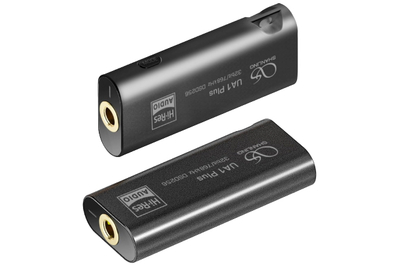The 4 Best Portable Headphone Amps With Built-In DAC of 2025

The Shanling UA1 Plus is a great choice if you want a small, capable amp/DAC that costs around $50. It’ll work well with almost all mainstream headphones and earphones, but audiophiles who have low-sensitivity headphones with balanced cables will be much better off with our top pick.
You’ll barely notice it in your pocket. The UA1 Plus is small, about a third the size and a quarter of the weight of the Fosi DS1. It includes a lanyard that makes this tiny amp/DAC easier to keep track of, or to attach to a key ring or purse.
There’s a single unbalanced 3.5 mm headphone output on top but no balanced output. On the bottom is a USB-C port. Shanling includes a detachable USB-C–to–USB-C cable that can be easily replaced if damaged, plus a USB-C–to–USB-A adapter.
A Mode button on the side lets you control play/pause and volume. The play/pause function works well, but we found it easier to control volume directly from our phones.
This amp packs a lot of punch for its size and price. The UA1 Plus put out 78.6 mW into 32 ohms, which is lower than our top pick but about 39% more than our previous budget pick, the Hidizs S3 Pro. Into 250 and 600 ohms, respectively, output was 10.3 and 4.3 mW — not impressive, but more than similarly priced competitors could muster.
The UA1 Plus amp is more than powerful enough to drive typical headphones with most music. In our worst-case power-listening test, it was able to get the high-impedance Beyerdynamic DT 880 headphones up to a reasonable volume, but the low-sensitivity HiFiMan HE6se headphones were a bit on the quiet side. For comparison, the Fosi DS1 amp produced only a slight increase in maximum volume from its unbalanced input but delivered considerably more volume from its balanced output.
The Eddict app (for iOS and Android) gives you a little extra control. You can set volume in 100 steps, which is a much finer adjustment than your phone’s volume buttons offer. You can set high or low gain; the latter may give you a more usable volume range with high-sensitivity earphones. You can adjust the left-to-right channel balance.
You can also choose among five different digital filters, each of which produces a slightly different sound. This is a feature found on some audiophile DACs, and it’s something that audiophiles will enjoy experimenting with.
The UA1 Plus remembers any settings you make in the app, so if you switch to a different device that doesn’t have the app, your settings will still be in effect.
Like our top pick, this amp is powered by your mobile device. Running the amp at a moderate volume with Sony MDR-7506 headphones drew only 0.043 amps from our laptop’s USB jack, which is about one-third as much as our top pick drew. That’s a plus if maximizing the run time of your phone’s battery is important.
The UA1 Plus offers good digital-file compatibility: PCM digital audio files up to 32-bit/384-kHz and DSD at sample rates up to 11.4 MHz (DSD256).
We recently tested the newer and slightly cheaper Shanling UA Mini, which is a simpler, dongle-style amp/DAC that may be better for use with low-sensitivity headphones because its maximum output is a little higher: 197.3 mW into 32 ohms, which is 4 dB more than the UA1 Plus. You wouldn’t notice that difference with earbuds or standard headphones, but with large, low-sensitivity headphones, you probably would. The UA Mini doesn’t connect to an app, so it doesn’t have the sound-adjustment options of the UA1 Plus, and the cable is not detachable (and thus not replaceable if it gets damaged).
Flaws but not dealbreakers
The volume function is clumsy. To raise the volume, you must tap the control button twice, then hold it down. To lower the volume, tap it twice, then twice again, and hold it down. The adjustment is also abrupt, so you run the risk of pushing the volume uncomfortably high by accident. You’re better off using your phone’s volume controls.
It’s not loud enough when used with low-sensitivity headphones. If you own large planar-magnetic headphones with rated sensitivity less than about 90 dB (such as the HiFiMan HE6se), you’ll be happier stepping up to our top pick, the Fosi DS1.







